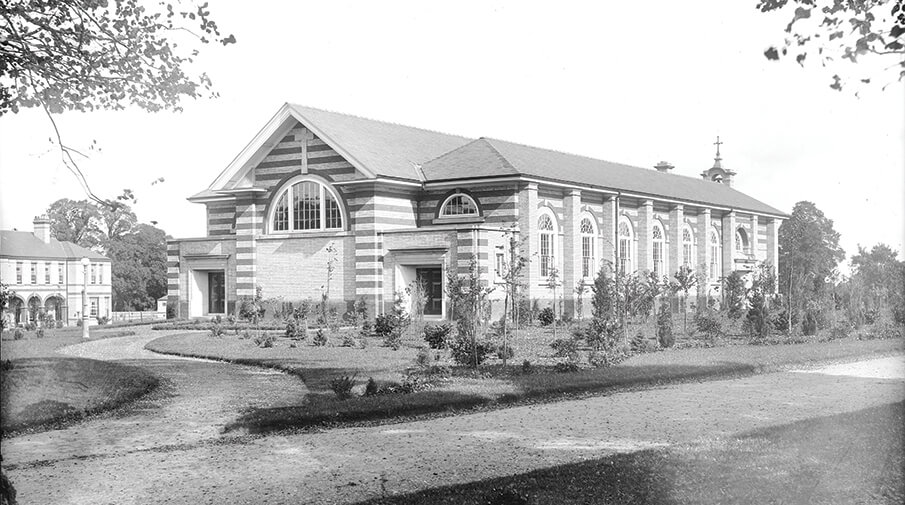Evoking memories of her childhood growing up and living in Epsom, Fatima rewinds back to the role of the chapel, the historical identity of the psychiatric hospitals and reflects on the positive changes towards mental health.
“Blossom is underfoot. A blackbird, somewhere overhead, sings her pin-sharp repertoire. A bus slowly accelerates alongside. The Horton Chapel comes into view. The Grade II listed building is tucked away, neatly within Epsom’s historic 1,000 acre, former psychiatric hospital site. I take in a deep breath.
It’s a strange feeling isn’t it when you revisit a place that’s embedded deep in your childhood psyche. Even though three decades have passed since I’ve been back here, once through the huge double-door entrance, a flurry of episodic memories escape, deep-hidden- hippocampus-stuff, floods straight back into my consciousness. The main one being of my Mum having to drag my brother and I away from the carpet and cartoons on a Sunday morning to attend mass at Horton chapel.
I laugh, remembering how beyond bored we’d both get and how the nauseating smell of ‘hospital’ as we walked in would always make me want to bury my head in my Mum’s cardigan, if only to drown it out with the scent of her pretty perfume.
Social sanctuary
Back then and up until its final closure in 1997, Horton chapel’s role was to provide solace for people experiencing mental distress and from 1961, the rear-side was a music therapy centre; a pivotal space for ‘patients’ (as they were referred to in those days) to explore their creativity.
It was a place for them to worship, the public were also welcome, as well as staff from the surrounding five hospitals, too. Horton Hospital was the second of the five psychiatric hospitals to open after the Manor Hospital, followed by St Ebba’s (Ewell Epileptic Colony), Long Grove and West Park.
Both my parents came to the UK to work, as psychiatric nurses.
In the early 1970s, as part of a government drive to recruit overseas staff to the NHS, many nurses, like my Mum and Dad, came from The Philippines and Mauritius, respectively, as well as India, Pakistan, Bangladesh, Sri Lanka to name a few. Many were positioned in Epsom’s psychiatric hospital cluster.
It was a community where a charge nurse of Afro Caribbean heritage worked alongside someone from Spain, Portugal or Ireland; they made their lives in Epsom (and many still live locally) and even though their hearts were far from home, a truly diverse and culturally rich workforce was created, with families and friendships formed that are still reflected in the diversity of Epsom today; many now with second and third generations now thriving in the ‘hood.
Understanding through heritage
But theirs wasn’t an easy job. As a child, I would often see how my parents would interact, care and connect with ‘patients’ – some severely struggled with basic speech and mobility, but not all. I’d sit inside my Dad’s orange Datsun as we’d wait to pick Mum up from her shift at the Manor Hospital and it wasn’t unusual for a disheveled man in his 30s to approach the car with a bucket and spade, smile widely and then bang on the bonnet. Some would just sign my Dad for a cigarette or a light. Even at the chapel, if there was an embarrasing outburst of love for the anti-Christ or if someone soiled themselves, the response was always patience, love and care – a very far cry from the dark days of asylums. However, for these mainly adult residents in their 30s – 60s, male and female, it was apparent that they’d been admitted into the system at a time when their difference was a real burden and carried much, much shame.
Thankfully, we continue to view mental health and disability with humanity and heart and have come a long way further on; understanding and empathizing with every individuals’ ability and the many ways to explore, overcome and adapt when it comes to physical and mental learning difficulties. As a small child, understandably, I’d often see it through frightened eyes. Not just because some of the physical deformities were very severe, more so because there was a real sadness that being different, looking different and thinking differently, back in those day, could mean this kind of incarceration. Years later, I came to realise that it’s probably likely that some had been admitted due to very simple behavioural traits and, or because they were of mixed race or born outside marriage – basically any socially inacceptable behavior in a world that didn’t know any better.
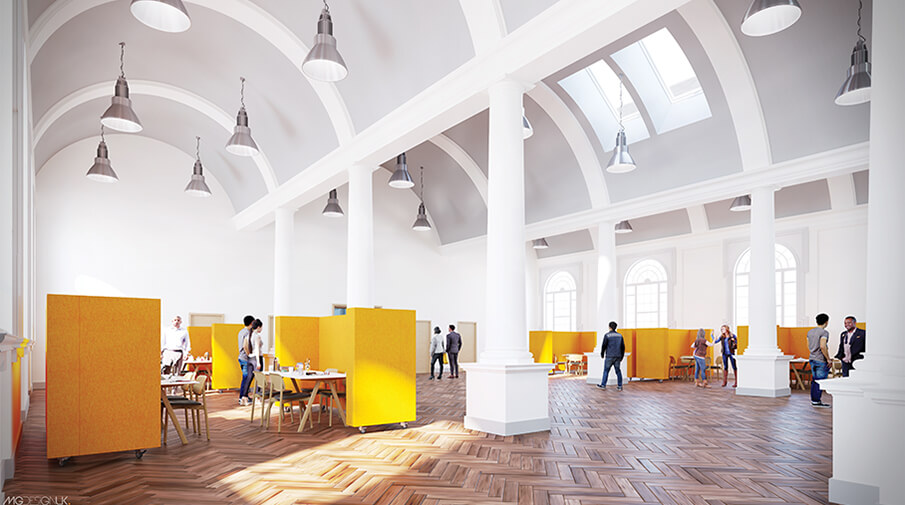
A Dynamic Future
Institutions like these psychiatric hospitals in Epsom (the largest of its kind in Europe) underwent huge reform following the introduction of ‘care in the community’ policies in the 1990s and the buildings were demolished to make way for new homes and flats. For some, the hospitals were a place of purpose, friendship, security, and sometimes recovery. Others understandably suffered under the constraints of institutional life.
And now, for me, looking at The Horton through eyes of a 43-year-old, mum-of-two, to see how it’s about to be used to express all that historical identity, (still palpable in the building) and reignite it with fresh, new, creative energy – is truly magical.
These days we question so much about the past and how it’s taught and while all of this is absolutely right, it’s the very reason why I think it’s vital to understand the role of the chapel before it officially opens and becomes The Horton. To fully appreciate its future and how it will bring something really genuine to the diverse and creative community of Epsom, is from knowing its roots are in a place of sanctuary, spirit, hope and expression.”
Behind the scenes
Once inside a sympathetic architectural conversion has enhanced the stunning historic features of the building whilst delivering excellent contemporary facilities.
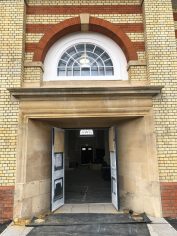
The entrance to The Horton, in keeping with the chapel’s original layout.
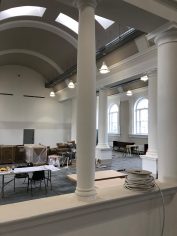
The main social space where people are brought together with a permanent exhibition on the hospitals and Epsom’s historical identity.
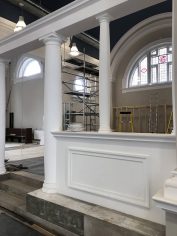
The new site for the café and bar is where the altar and organ once stood.
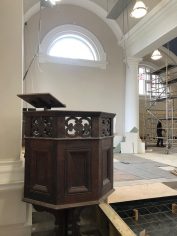
Sustainability and repurposing has been key as original pews and the pulpit remain on site.
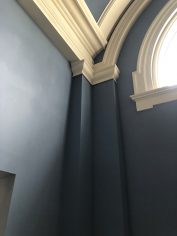
The original music therapy centre will now be home to a dynamic programme of inspired activities and workshops for all ages.
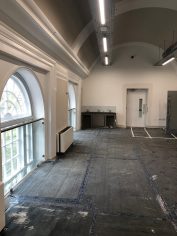
Impressive new mezzanine floor creates an engaging space and artist studio with lift access.
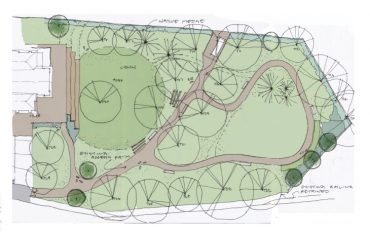
Conceptual designs by local landscape architect Sian Kelly and Guarda landscape architecture.
The green landscape was a very important element behind the building of Epsom’s asylums more than 100 years ago. The benefits of walking to take in the clean air were prescribed as part of the patients’ regular routines.
Trustee Maria Reeves said: “In developing The Horton as a creative place for the community, our vision is not just for the chapel building itself – it extends to the whole site. We want The Horton Gardens to be a safe place to enjoy views of the heritage setting and interact with nature. Drawing on its history as a place of refuge for those experiencing mental stress or illness, we want visitors of all ages to feel inspired and rejuvenated through outdoor creative and wellbeing activities too.”
Words by Fatima Truscott





